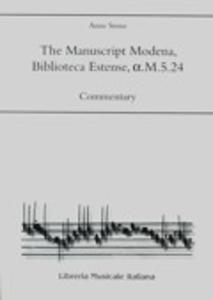The Manuscript Modena, Biblioteca Estense α.M.5.24 (ModA). Commentary
CODICE: ISBN 8870963314 EAN 9788870963311
AUTORE/CURATORE/ARTISTA :
Author: Anne Stone With an essay on illumination by: Federica Toniolo
EDITORE/PRODUTTORE : LIM Libreria Musicale Italiana
COLLANA/SERIE : Ars nova. Nuova serie, 1
DISPONIBILITA': Esaurito
TITOLO/DENOMINAZIONE:
The Manuscript Modena, Biblioteca Estense α.M.5.24 (ModA). Commentary
PREZZO : EUR 30,00€
CODICE :
ISBN 8870963314
EAN 9788870963311
AUTORE/CURATORE/ARTISTA :
Author: Anne Stone With an essay on illumination by: Federica Toniolo
EDITORE/PRODUTTORE:
LIM Libreria Musicale Italiana
COLLANA/SERIE:
Ars nova. Nuova serie, 1
ANNO:
2005
DISPONIBILITA':
Esaurito
CARATTERISTICHE TECNICHE:
171 pages
Paperback
cm 17 x 21
DESCRIZIONE:
Publisher's description:
Manuscript α.M.5.24 of the Biblioteca Estense in Modena (Mod A), presented here in photographic reproduction, is one of the few surviving sources of sacred and secular polyphony from the turn of the fifteenth century. To a greater degree than other surviving manuscripts, it bears witness to the importance of French song composition, style, and notation among Italian composers working in courts and monasteries of Lombardy, the Veneto, and Tuscany, and contains some of the most extensive explorations of the complex rhythmic practice of the Ars subtilior in Italy. Five complete quinterns survive, and 66 of its compositions are unique to the manuscript. Among these unica are 30 compositions by Matteo da Perugia, six of eight surviving French songs of Antonello da Caserta, and works by well-known composers like Zacara da Teramo, Jacob Senleches, and Johannes Ciconia, as well as the lesser-known figures Bartolomeo da Bologna, Johannes de Janua, Magister Egardus, and Magister Egidius.
These works deserve to be better known, and their obscurity is the result of a combination of historical and historiographical factors. There is no composer of this generation whose surviving works are as numerous as those of Machaut and Landini in the fourteenth century or Du Fay and Binchois in the fifteenth. From their tributes in individual pieces, we know that composers were patronized by the ruling families of various north Italian courts, such as the Visconti, the Carrara, and the Malatesta, but to date we lack enough information to piece together a comprehensive history of the musical lives of any of these centers much before the third decade of the fifteenth century. The turbulence caused by the papal schism, which lasted from 1378 to 1417, either prevented the large-scale patronage of music composition that the popes of the fifteenth and sixteenth centuries routinely provided, or at least hid much of the evidence of such patronage.' Furthermore, Italian patrons of the early fifteenth century did not seem regularly to commission sumptuous musical manuscripts the way their later fifteenth-century counterparts did. For all these reasons, the decades surrounding the turn of the fifteenth century have long been relegated in music history textbooks to the status of "transition": there has developed neither a universally-accepted label for the period, perched as it is between "late medieval" and "early Renaissance," nor have we identified a composer of sufficient stature who can be taken to represent it the way Machaut and Du Fay serve their respective periods.
Our precarious knowledge of music produced in the courts of northern Italy and the schismatic papal chapels has nevertheless increased greatly in recent years. A number of music manuscript fragments has been recovered from the bindings of later books (and will surely continue to be uncovered in the future). But a large number of manuscripts, and therefore compositions, must of course be assumed to be lost. In this context, the historical importance of the few manuscripts of north Italian provenance that do survive more or less intact - the Lucca Codex (a number of its leaves were rescued from the bindings of sixteenth-century notarial books), the Reina Codex, and the subject of the present facsimile edition, the manuscript Mod A - can scarcely be exaggerated.'
(From the Introduction)
GENERE: Libri ,Saggi ,



